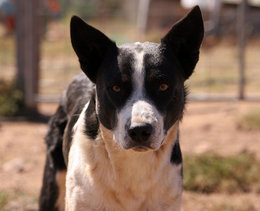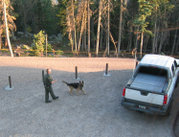Dogs
Working Dogs
Assistance Dog | Herding Dog | Attack Dog | Detection Dog | Freighting | Guard Dog | Hunting Dog | Livestock Guardian Dog | Police Dog | Rescue Dog | Search and Rescue Dog | Sheep Dog | Sled Dog | Therapy Dog | Treeing | Wardog | Military Animal
 This working dog is a border
collie
mix.
This working dog is a border
collie
mix.
A working dog refers to a canine working animal, i.e. a dog
that is not merely a pet but learns and performs tasks to assist and/or entertain
its human companions, or a breed of such origin.
Arguably the variety of -often exclusive- canine jobs is a better
justification for the dog's honorary title "man's best friend" than the more
accidental popularity as pet number one in western cultures.
Definition
Within this general description, however, there are several ways in which the
phrase is used.
- To identify any dog that performs any task on a regular basis to assist
people. In this context, a dog who helps a rancher manage cattle or who performs
tricks for a trainer who receives pay for its acts is a working dog, as is
an assistance dog.
This might be in comparison to a
companion dog, whose purpose is primarily as a pet.
- To distinguish between show
dogs that are bred primarily for their appearance in an attempt to match
a breed club's
detailed description of what such a breed
should look like, and working dogs that are bred primarily for their
ability to perform a task. For example, a
Border Collie that is a champion show dog is not necessarily good at herding
sheep; a Border Collie that is a champion at
sheepdog trials might be laughed out of the show ring for its nonstandard
appearance. It is possible that a specimen may excel in both appearance and
performance, but it is very unlikely.
- For some breeds, there are separate
registries for tracking the ancestry of working dogs and that of show
dogs. For example, in Australia, there are separate registries for working
and show Australian
Kelpies; the working registry encourages the breeding of any Kelpies with
a strong instinct to herd, no matter their appearance or coat color; the show
registry encourages breeding only among Kelpies whose ancestors were registered
as show dogs and who have only solid-colored coats.
- As a catch-all for dog breeds whose original purpose was to perform tasks
that do not fit into a more specific category of work. For example, the
American Kennel Club uses Working Dogs to describe breeds who were
originally bred for jobs other than herding or hunting. Such jobs might include
pulling carts, guarding, and so on. See Working Dog Group.
Jobs performed by dogs
 A detection dog at work
A detection dog at work
Although most modern dogs are kept as
pets, there are still
a tremendous number of ways in which dogs can and do assist humans, and more
uses are found for them every year. The following list provides an idea of the
versatility of dogs:
- Service dogs assist
people who are physically unable to do everything that they need to do. This
includes guide dogs for the
blind, hearing dogs for the deaf, and others.
- Therapy dogs visit people
who are incapacitated or prevented in some way from having freedom of movement;
these dogs provide cheer and entertainment for the elderly in retirement facilities,
the ill and injured in hospitals, and so on. The very act of training dogs
can also act as a therapy for human handlers, as in a prisoner rehabilitation
project.
- Hunting dogs assist
hunters in finding, tracking, and retrieving game, or in routing vermin.
- Tracking dogs help
find lost people and animals or track down possible criminals.
- Cadaver dogs use their
scenting ability to discover bodies at the scenes of disasters or crimes.
- Rescue dogs assist people
who are in difficult situations, such as in the water after a boat disaster,
lost in the mountains, covered in snow avalanches and so on.
- Detection dogs
of a wide variety help to detect termites in homes, illegal substances in
luggage, bombs, chemicals, and many other substances.
-
Military Working Dogs or
K9 Corps are used by armed forces in many of the same roles as civilian
working dogs, but in a miliary context. In addition, specialized military
tasks such as mine detection or wire laying have been assigned to dogs.
- Police dogs, also sometimes
called K9 Units, are usually trained to track or immobilize possible criminals
while assisting officers in making arrests or investigating the scene of a
crime. Some are even specially trained for anti-terrorist units, as in Austria.
- Herding dogs are still
invaluable to shepherds and cattle herders around the world for managing their
flocks; different breeds are used for the different jobs involved in herding,
and for guarding the flocks and herds. Modern herding dogs help to control
wild geese in parks or goats used for weed control. A good dog can adapt to
control any sort of domestic and many wild animals.
- Guard dogs and watch dogs
help to protect private or public property, either inliving or used for patrols,
as in the military and with security firms.
- Fighting
dogs are used (or abused) to generate income in dog
fighting or as dogs of war.
- Sled dogs, although today primarily
used in sporting events, still can assist in transporting people and supplies
in rugged, snowy terrain.
-
Performing dogs such as
Circus dogs and
dog actors are trained to perform acts that are not intrinsically
useful, but instead provide entertainment to their audience or enable human
artistic performances.
- Canine
mascots, who accompany their teams or organizations for support and
publicity
New Advancements in Water Rescue
Several cities in Italy are experimenting with working dogs as rescue swimmers.
In this situation, a strong and well-trained dog is equipped with flotation
devices and dropped in the water near a floundering swimmer. The swimmer then
grabs onto the dog, and the animal tows the swimmer to shore. The
Newfoundland has long been used for water rescue, not only on shore, but
from fishing boats as well.
Rescue and Disaster Dogs
Dogs are commonly used as search and rescue workers in cases of lost persons
and disasters. The St.
Bernard was historically used in Europe in the case of avalanches and lost
travelers. Rescue dogs in the US are used in thousands of lost person searches
each year saving countless human lives. In the aftermath of the 9-11 attacks
in New York, rescue dogs searched the rubble pile for survivors. When searching
such large disaster sites some dogs become so disturbed at being unable to find
any survivors that people are "planted" for the dogs to find so that
the dogs retain their enthusiasm and work ethic.
Working dogs as pets
The breeding
of working dogs has resulted in highly intelligent, hardy, alert dogs that are
often attractive and extremely loyal. As a result, many working breeds are sought
after as family pets. Unfortunately, many owners fail to consider that such
dogs are rarely passive, so the abandonment rate is very high.
Working dogs make excellent pets as long as potential owners realize that these
dogs must be given 'work' to do. Dogs that are not to be used for their original
purpose must be trained from a young age and are best suited to active persons
and families.
Obedience training, dog sports
such as flyball,
dancing and agility,
informal or novelty shows, and trial work are all excellent channels for these
breeds' energy. At the very least they must have daily walks or other exercise
at an appropriate level for the breed, given toys, played with, and provided
with human company.
Working dogs who are chained, left alone, or ignored become bored, vocal, and
even neurotic;
they may exhibit malaise, lethargy, or destructive behaviour or become escape
artists. Working dogs inappropriately chosen as pets are far too often
surrendered to shelters when their inventiveness and determination to find
something to do exceeds their owner's tolerance for destruction. Working dogs
were bred to work all day every day. It is a tragedy for both the dog and the
owner when the owner underestimates the amount of attention and time a working
dog requires.
Sources and References
- The
National Geographic Channel has aired several dozen episodes of a
documentary program "Dogs with Jobs"[1],
portraying dogs in useful, often less-common, jobs.
Home | Dogs | Dog Anatomy | Dog Breeding | Dog Breeds | Dog Equipment | Famous Dogs | Fictional Dogs | Dog Health | Dog Law | Dog Organizations | Dogs as Pets | Dog-Related Professions and Professionals | Dog Show | Dog Sports | Dog Training | Dog Types | Working Dogs | License
Dogs, made by MultiMedia | Free content and software
This guide is licensed under the GNU
Free Documentation License. It uses material from the Wikipedia.
 A detection dog at work
A detection dog at work This working dog is a border
collie
mix.
This working dog is a border
collie
mix.
 A detection dog at work
A detection dog at work